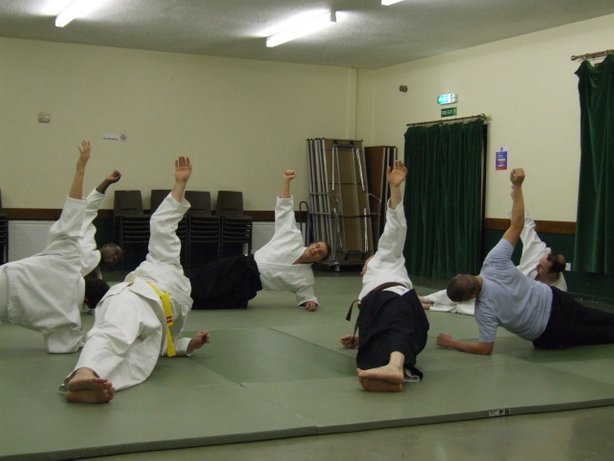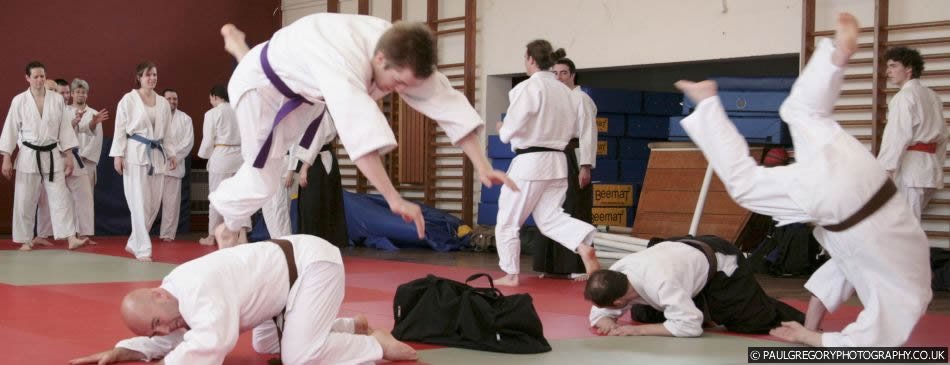Thatcham Club
A typical session
What does a typical Aiuchi Jiu Jitsu session involve? Well there is obviously some formality involved, but we try to keep that to a minimum. If you want to know more about our Jitsu principles, Aiuchi philosophy or martial arts etiquette check out the assoication website in the links page.
We get a number of enquiries as to what is involved in a Jiu Jitsu session so here is a brief summary to give you an idea of what to expect.
The doors open at 7.30, and students will arrive to ensure that when the hall is free we can move in and set the mats out and then get changed ready to train. We wear white pyjama suits (gis) because they give better support, and are cheaper and tougher than tracksuits and t-shirts. T-shirts can tear quite easily when you’ve got the hang of some of the more practiced techniques!
As a novice you can generally wear what you like providing that you can move freely in it, there’s no metal or other sharp edges and it is not too hot!
If you already have a gi you are free to wear this and a white belt. If you want a gi we can get one for you, or you can get one yourself. We recommend Judo or Jiu Jitsu gis, available from most sports shops that sell martial arts equipment. Karate or Tae Kwon Do or similar gis are not generally tough enough to survive the training. Feel free to ask us for advice if you want to get one.
We ask that you have short clean nails and remove any jewellery (for safety). Jiu Jitsu involves close contact, so its nice to be hygenic too.
All times are approximate and subject to the whim of the instructor. The wonderful thing about Aiuchi Jiu Jitsu is that no two sessions are alike. The following is therefore only a rough idea.
7.45 – 8:00
Warm up
The first 15 minutes of the session will be spent warming up and stretching, getting the body ready to train. This could be a bit of jogging, star jumps, stretches, sit ups, press-ups etc. It is not cardio work – the body does not learn very well when very tired. The purpose is just to get the blood flowing and to reduce the likelihood of injuries, such as pulled muscles or strains.
Line up and Rei
This is how we formally say hello to each other and start the session.
8:00 – 8:15
Ukemi practice, or falling.
In order to train safely we spend some time learning how to fall over – and be thrown – safely. These are also good self defence skills – you are much more likely to fall over or trip than be attacked by a knife-wielding maniac, and practicing falling helps students learn safe ways to fall. We will normally practice kneeling falling and standing, and students also learn some of the more acrobatic falling, for example dive forward rolls or falling over objects. Falling practice is fairly vital to ensure that training is safe, and it can also be a fairly intense workout, but only if you want it to be.
8:15 ish
The meat of the session, we will practice striking, locks, throws, immobilisations, or weapons defences. This part of the session varies wildly, we may learn ground holds one week, and defences against a broken bottle or knife the next. We could rattle through a dozen different throws, or focus on one. We may look at themes, or maybe just one weapon and the different ways that it could be used against you. We don’t have many katas in our style of Jiu Jitsu, but we could look at these during this part of the session. Training in normally in pairs or small groups.
This part of the session could involve groundwork (essentially wrestling) weapons defences, work with pads and gloves (in some respects similar to sparring you may get in karate or kickboxing, but with a distinct Aiuchi Jiu Jitsu flavour) or judo-esque stand up randori.
It is in this part of the session that we will also do the pressure testing type of training; two man attacks, ground defences, v’s, circles and gauntlets
It is true that no two sessions are alike, and this is why students don’t need to attend every session, there is no lesson plan that is followed and each technique has many different levels. We are continually revisiting techniques to learn the next level or application and it is surprising how many times you learn something new about a technique you thought you already knew. If you miss one week you can easily catch up the next time we look at that technique.
Although we have a published syllabus (available from www.aiuchi.net) the techniques we teach are designed to demonstrate the principles of Aiuchi Jiu Jitsu, they are not the be all and end all of the style. We don’t insist on students just learning all the syllabus for the next grade. One week we may look at techniques from the yellow belt syllabus, the next from the blue belt. There is no rigid structure because we focus on teaching the principles of Aiuchi.
9:30 - 9:45
Demonstrations, the sensei may ask to see what the students have learnt that night, followed by a Warm down and a final Rei to formally finish the session.
9:45
Mats away and get changed.
Learning Aiuchi has three parts, learning the actual technique, understanding how it works, and then applying the technique.
If you are not sure what any of this entails, feel free to email us for more info, or turn up and have a go!
Oh and we generally head to the pub afterwards.
Martial arts training is all about balance, and if you have exercised and trained your body (and mind) then you must also train the stomach and taste buds in the pub. It’s only correct. You don’t need to come to the pub with us, but we’d like you to!
We are a very social style, and so as well as local training we also have regular inter-club training events and socials.

